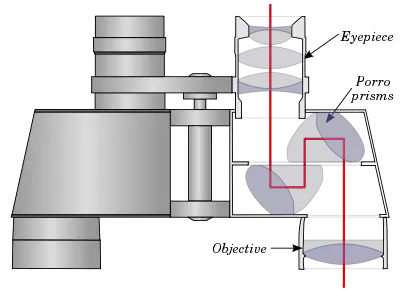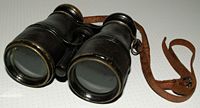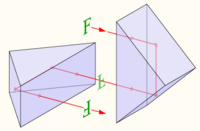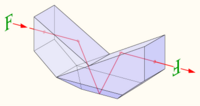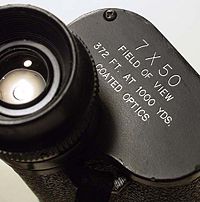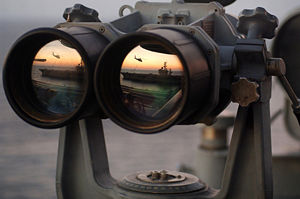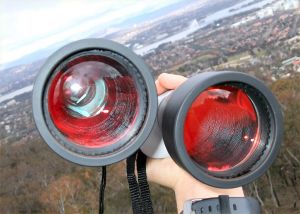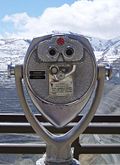Binoculars
Binocular telescopes, or binoculars (also known as field glasses), are two identical or mirror-symmetrical telescopes mounted side-by-side and aligned to point accurately in the same direction, allowing the viewer to use both eyes (binocular vision) when viewing distant objects. Most are sized to be held using both hands, although there are much larger types.
Unlike a monocular telescope, binoculars give users a three-dimensional image: The two views, presented from slightly different viewpoints to each of the viewer's eyes, merge to produce a single perceived view with a sensation of depth, allowing distances to be estimated. There is no need to close or obstruct one eye to avoid confusion, as is usual with monocular telescopes. When using hand-held binoculars, the two hands and the head form a steady three-point platform, with less tendency to shake than with a single-eye instrument.
Binoculars are regularly used by bird watchers, hunters, land surveyors, and tourists appreciating distant scenery. They may also be used by sports fans and theater-goers. They are often used by military personnel.
Optical design
Galilean binoculars
Almost from the invention of the telescope in the seventeenth century the advantages of mounting two of them side by side for binocular vision seems to have been explored.[1] Most early binoculars used Galilean optics; that is they used a convex objective and a concave eyepiece lens. The Galilean design has the advantage of presenting an erect image but has a narrow field of view and is not capable of very high magnification. This type of construction is still used in very cheap models and in "opera glasses," or theater glasses.
Porro prism binoculars
Named after Italian optician Ignazio Porro, who patented this image erecting system in 1854, and later refined by makers like Carl Zeiss in the 1890s, binoculars of this type use a Porro prism in a double prism Z-shaped configuration to erect the image. This feature results in binoculars that are wide, with objective lenses that are well separated but offset from the eyepieces. Porro prism designs have the added benefit of folding the optical path so that the physical length of the binoculars is less than the focal length of the objective and wider spacing of the objectives gives better sensation of depth.
Roof prism binoculars
Binoculars using Roof prisms may have appeared as early as the 1880s in a design by Achille Victor Emile Daubresse.[2] Most roof prism binoculars use either the Abbe-Koenig prism (named after Ernst Karl Abbe and Albert Koenig and patented by Carl Zeiss in 1905)[3] or Schmidt-Pechan prism (invented in 1899) designs to erect the image and fold the optical path. They are narrower, more compact, and more expensive than those that use Porro prisms. They have objective lenses that are approximately in line with the eyepieces.
Porro vs. Roof prisms
Aside from the difference in price and portability noted above, these two designs have effects on reflections and brightness. Porro-prism binoculars will inherently produce an intrinsically brighter image than roof-prism binoculars of the same magnification, objective size, and optical quality, as less light is absorbed along the optical path. However, as of 2005, the optical quality of the best roof-prism binoculars with up-to-date coating processes as used in Schmidt-Pechan models is comparable with the best Porro glasses, and it is possible that roof prisms will dominate the market for high-quality portable binoculars. The major European optical manufacturers (Leica, Zeiss, Swarovski) have discontinued their Porro lines, and Japanese manufacturers (Nikon, Fujinon, and others) may follow suit.
Optical parameters
Binoculars are usually designed for the specific application for which they are intended. Those different designs create certain optical parameters (some of which may be listed on the prism cover plate of the binocular). Those parameters are:
Magnification—The ratio of the focal length of the eyepiece divided into the focal length of the objective gives the linear magnifying power of binoculars (sometimes expressed as "diameters"). A magnification of factor 7, for example, produces an image as if one were seven times closer to the object. The amount of magnification depends upon the application the binoculars are designed for. Hand-held binoculars have lower magnifications so they will be less susceptible to shaking. A larger magnification leads to a smaller field of view.
Objective diameter—The diameter of the objective lens determines how much light can be gathered to form an image. It is usually expressed in millimeters.
It is customary to categorize binoculars by the magnification × the objective diameter; e.g. 7×50.
Field of view—The field of view of binoculars is determined by its optical design. It is usually notated in a linear value, such as how many feet (meters) in width will be seen at 1,000 yards (or 1,000 m), or in an angular value of how many degrees can be viewed.
Exit pupil—Binoculars concentrate the light gathered by the objective into a beam, the exit pupil, whose diameter is the objective diameter divided by the magnifying power. For maximum effective light-gathering and brightest image, the exit pupil should equal the diameter of the fully dilated iris of the human eye—about 7 mm, reducing with age. Light gathered by a larger exit pupil is wasted. For daytime use an exit pupil of 3 mm—matching the eye's contracted pupil—is sufficient. However, a larger exit pupil makes alignment of the eye easier and avoids dark vignetting intruding from the edges.
Eye relief—Eye relief is the distance from the rear eyepiece lens to where the image is formed. It determines the distance the observer must position his or her eye behind the eyepiece in order to see an unvignetted image. The longer the focal length of the eyepiece, the greater the eye relief. Binoculars may have eye relief ranging from few millimeters to 2.5 centimeters or more. Eye relief can be particularly important for eyeglass wearers. The eye of an eyeglass wearer is typically further from the eye piece which necessitates a longer eye relief in order to still see the entire field of view. Binoculars with short eye relief can also be hard to use in instances where it is difficult to hold them steady.
Optical coatings
Since binoculars may have sixteen air-to-glass surfaces. With light lost at every surface, optical coatings can significantly affect their image quality. When light strikes an interface between two materials of different refractive index (e.g., at an air-glass interface), some of the light is transmitted, some reflected. In any sort of image-forming optical instrument (telescope, camera, microscope, etc.), ideally no light should be reflected; instead of forming an image, light which reaches the viewer after being reflected is distributed in the field of view, and reduces the contrast between the true image and the background. Reflection can be reduced, but not eliminated, by applying optical coatings to interfaces. Each time light enters or leaves a piece of glass; about 5 percent is reflected back. This "lost" light bounces around inside the binoculars, making the image hazy and hard to see. Lens coatings effectively lower reflection losses, which finally results in a brighter and sharper image. For example, 8x40 binoculars with good optical coatings will yield a brighter image than uncoated 8x50 binoculars. Light can also be reflected from the interior of the instrument, but it is simple to minimize this to negligible proportions. Contrast is also improved by good coating due to the partial elimination of internal reflections.
A classic lens-coating material is magnesium fluoride; it reduces reflections from 5 percent to 1 percent. Modern lens coatings consist of complex multi-layers and reflect only 0.25 percent or less to yield an image with maximum brightness and natural colors. For roof-prisms, anti-phase shifting coatings are sometimes used which significantly improve contrast. The presence of a coating is typically denoted on binoculars by the following terms:
- Coated optics: One or more surfaces coated.
- Fully coated: All air-to-glass surfaces coated. Plastic lenses, however, if used, may not be coated.
- Multi-coated: One or more surfaces are multi-layer coated.
- Fully multi-coated: All air-to-glass surfaces are multi-layer coated.
Phase-corrected prism coating and dielectric prism coating are recent (in 2005) effective techniques for reducing reflections.
Mechanical design
Focusing and adjustment
Binoculars to be used to view objects that are not at a fixed distance must have a focusing arrangement. Traditionally, two different arrangements have been used to provide focus. Binoculars with "independent focus" require the two telescopes to be focused independently by adjusting each eyepiece, thereby changing the distance between ocular and objective lenses. Binoculars designed for heavy field use, such as military applications, traditionally have used independent focusing. Because general users find it more convenient to focus both tubes with one adjustment action, a second type of binocular incorporates "central focusing," which involves rotation of a central focusing wheel. In addition, one of the two eyepieces can be further adjusted to compensate for differences between the viewer's eyes (usually by rotating the eyepiece in its mount). This is known as a diopter. Once this adjustment has been made for a given viewer, the binoculars can be refocused on an object at a different distance by using the focusing wheel to move both tubes together without eyepiece readjustment.
There are also "focus-free" or "fixed-focus" binoculars. They have a depth of field from a relatively large closest distance to infinity, and perform exactly the same as a focusing model of the same optical quality (or lack of it) focused on the middle distance.
Zoom binoculars, while in principle a good idea, are generally considered not to perform very well.
Most modern binoculars have hinged-telescope construction that enables the distance between eyepieces to be adjusted to accommodate viewers with different eye separation. This adjustment feature is lacking on many older binoculars.
Image stabilization
Shake can be much reduced, and higher magnifications used, with binoculars using image-stabilization technology. Parts of the instrument which change the position of the image may be held steady by powered gyroscopes or by powered mechanisms driven by gyroscopic or inertial detectors, or may be mounted in such a way as to oppose and dampen sudden movement. Stabilization may be enabled or disabled by the user as required. These techniques allow binoculars up to 20× to be hand-held, and much improve the image stability of lower-power instruments. There are some disadvantages: The image may not be quite as good as the best unstabilized binoculars when tripod-mounted, stabilized binoculars also tend to be more expensive and heavier than similarly specified non-stabilized binoculars.
Alignment
Well-collimated binoculars, when viewed through human eyes and processed by a human brain, should produce a single circular, apparently three-dimensional image, with no visible indication that one is actually viewing two distinct images from slightly different viewpoints. Departure from the ideal will cause, at best, vague discomfort and visual fatigue, but the perceived field of view will be close to circular anyway. The cinematic convention used to represent a view through binoculars as two circles partially overlapping in a figure-of-eight shape is not true to life.
Misalignment is remedied by small movements to the prisms, often by turning screws accessible without opening the binoculars, or by adjusting the position of the objective via eccentric rings built into the objective cell. Alignment is usually done by a professional although instructions for checking binoculars for collimation errors and for collimating them can be found on the Internet.
Applications
General use
Hand-held binoculars range from small 3x10 Galilean opera glasses, used in theaters, to glasses with 7 to 12 diameters magnification and 30 to 50 mm objectives for typical outdoor use. Porro prism models predominate, although bird watchers and hunters tend to prefer, and are prepared to pay for, the lighter but more expensive roof-prism models.
Many tourist attractions have installed pedestal-mounted, coin-operated binoculars to allow visitors to obtain a closer view of the attraction. In the United Kingdom, 20 pence often gives a couple of minutes of operation, and in the United States, one or two quarters gives between one-and-a-half to two-and-a-half minutes.
Military
Binoculars have a long history of military use. Galilean designs were widely used up to the end of the nineteenth century when they gave way to porro prism types. Binoculars constructed for general military are made more rugged than their civilian counterparts. They generally avoid more fragile center focus arrangements in favor of independent focus. Prism sets in military binoculars may have redundant aluminized coatings on their prism sets to guarantee they don’t lose their reflective qualities if they get wet. Military binoculars of the cold war era were sometimes fitted with passive sensors that detected active IR emissions, while modern ones usually are fitted with filters blocking laser beams. Further, binoculars designed for military usage may include a stadiametric reticle in one ocular in order to facilitate range estimation.
There are binoculars designed specifically for civilian and military use at sea. Hand held models will be 5x to 7x but with very large prism sets combined with eyepieces designed to give generous eye relief. This optical combination prevents the image vignetting or going dark when the binoculars are pitching and vibrating relative to the viewer's eye. Large, high-magnification, models with large objectives are also used in fixed mountings.
Very large binocular naval rangefinders (up to 15 meters separation of the two objective lenses, weight 10 tons, for ranging World War II naval gun targets 25 km away) have been used, although late-twentieth century technology made this application redundant.
Astronomical
Binoculars are widely used by amateur astronomers; their wide field of view making them useful for comet and supernova seeking (giant binoculars) and general observation (portable binoculars). The Galilean moons of Jupiter, Ceres, Neptune, Pallas, and Titan are invisible to the naked eye but can readily be seen with binoculars. Although technically visible unaided in pollution-free skies, Uranus and Vesta require binoculars for practical observation.
10x50 binoculars are limited to a magnitude of around +9.5, which means asteroids like Interamnia, Davida, Europa and, except under exceptional conditions Hygiea, are too faint to be seen with binoculars. Likewise too faint to be seen with binoculars are all moons except the Galileans and Titan, and the dwarf planets Pluto and Eris.
Of particular relevance for low-light and astronomical viewing is the ratio between magnifying power and objective lens diameter. A lower magnification facilitates a larger field of view which is useful in viewing large deep sky objects such as the Milky Way, nebula, and galaxies, though the large exit pupil means some of the gathered light is wasted. The large exit pupil will also image the night sky background, effectively decreasing contrast, making the detection of faint objects more difficult except perhaps in remote locations with negligible light pollution. Binoculars specifically for most astronomical uses have higher magnification and a larger aperture objective because the diameter of the objective lens determines the faintest star that can be observed.
Much larger binoculars have been made by amateur telescope makers, essentially using two refracting or reflecting astronomical telescopes, with mixed results. A very large professional instrument, although not one that would normally be called binoculars, is the Large Binocular Telescope in Arizona, U.S., which produced its "First Light" image on October 26, 2005. The LBT comprises two 8-meter reflector telescopes. While obviously not intended to be held to the eyes of a viewer, it uses two telescopes to view the same object, giving higher resolving power than a single instrument of the same light-gathering power, and allowing interferometric use.
Manufacturers
Some notable binocular manufacturers as of 2005:
1. European brands
- Leica GmbH (Ultravid, Duovid, Geovid: All are Roof)
- Swarovski Optik (SLC, EL: All are Roof; Habicht: Porro, but to be discontinued)
- Zeiss GmbH (FL,Victory, Conquest: All are Roof; 7x50 BGAT/T: Porro, 15x60 BGA/T Porro, discontinued)
- Eschenbach Optik GmbH (Farlux, Trophy, Adventure, Sektor…; some are Roof, some are Porro)
- Docter (the former Carl Zeiss Jena plant in Eisfeld. Nobilem 7x50, 8x56, 10x50, 15x60: Porro; Docter 7x40, 8x40, 10x40: Roofs)
- Optolyth (Royal: Roof; Alpin: Porro)
- Steiner GmbH (Commander, Nighthunter: Porro; Predator, Wildlife: Roof)
2. Japanese brands
- Canon Inc. (I.S. series, Porro variants)
- Nikon Co. (High Grade series, Monarch series, RAII, Spotter series: Roof; Prostar series, Superior E series, E series, Action EX series: Porro)
- Fujinon Co. (FMTSX, MTSX series: Porro)
- Kowa Co. (BD series: Roof)
- Pentax Co. (DCFSP/XP series; Roof, UCF series: Inverted Porro; PCFV/WP/XCF series: Porro)
- Olympus Co. (EXWPI series: Roof)
- Minolta Co (Activa, some are Roof, some are Porro)
- Vixen Co. (Apex/Apex Pro: Roof; Ultima: Porro)*
- Zenith
- Miyauchi Co. (Specialized in over-sized Porro binocualars)
* Also sells OEM products manufactured by the KAMAKURA KOKI CO. LTD. of Japan.
3. Chinese brands
In the early years of the twenty-first century, some mid-priced binoculars have become available in the internal Chinese market. A few of them are said to be comparable both in performance and in price to some of the better brands, with the great majority of them being inferior.
- Sicong (from Xian Stateoptics. Navigator series: Roof; Ares series: Porro)
- WDtian (from Yunnan State optics, all Porro)
- Yunnan State optics (MS series: Porro)
4. American brands
- Alpen*
- Barska
- Brunton
- Bushnell Performance Optics*
- Carson Optical
- Leupold & Stevens, Inc.*
- Simmons
- Vortex Optics
- Weaver
- William Optics
* Also sells OEM products manufactured by the KAMAKURA KOKI CO. LTD. of Japan.
5. Russian brands
- Yukon Advanced Optics
- Baigish
- Kronos
- Russian Military Binoculars (BPOc 10x42 7x30, BKFC series)
Notes
- ↑ Europa.com, [http://www.europa.com/~telscope/binohist.txt The Early History of the Binocular. Retrieved October 13, 2007.
- ↑ Photodigital.net, Achille Victor Emile Daubresse, forgotten prism inventor. Retrieved October 13, 2007.
- ↑ Company7, A History Of A Most Respected Name In Optics. Retrieved October 13, 2007.
ReferencesISBN links support NWE through referral fees
- Abrahams, Peter. The history of the telescope & the binocular, The First 300 Years of Binocular Telescopes, 2002. Retrieved September 3, 2019.
- Corbett, Bill. A Simple Guide to Telescopes, Spotting Scopes and Binoculars. New York: Watson-Guptill Publications, 2003. ISBN 0817458883
- Mullaney, James. A Buyer's and User's Guide to Astronomical Telescopes & Binoculars (Patrick Moore's Practical Astronomy Series). London, UK: Springer, 2007. ISBN 1846284392
- Neata, Emil. A Guide to Binoculars. Nightskyinfo.com. Retrieved September 3, 2019.
- Reid, William. Barr and Stroud Binoculars Edinburgh, UK: National Museums of Scotland, 2001. ISBN 1901663663
External links
All links retrieved October 31, 2023.
Credits
New World Encyclopedia writers and editors rewrote and completed the Wikipedia article in accordance with New World Encyclopedia standards. This article abides by terms of the Creative Commons CC-by-sa 3.0 License (CC-by-sa), which may be used and disseminated with proper attribution. Credit is due under the terms of this license that can reference both the New World Encyclopedia contributors and the selfless volunteer contributors of the Wikimedia Foundation. To cite this article click here for a list of acceptable citing formats.The history of earlier contributions by wikipedians is accessible to researchers here:
The history of this article since it was imported to New World Encyclopedia:
Note: Some restrictions may apply to use of individual images which are separately licensed.
